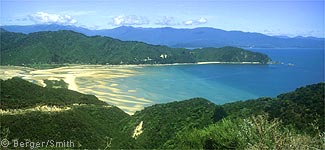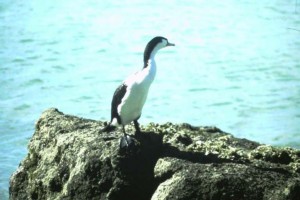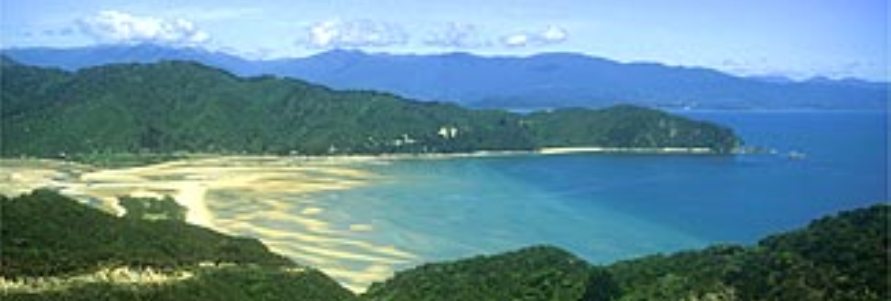
I have just eaten one of the best meals ever. Here’s how I made it: First, I strode into the choppy water of Tasman Bay and fought my way to a pile of rock. Timing my grabs between the waves, I reached underwater and yanked hard to pull off New Zealand green-lipped mussels, one or — if I’ was lucky — two at a time. I collected them in a backpacker’s stuff sack, and when I had enough, I cooked them up over a camp stove in a combination of lemonade, salt water, and some herbs I happened to have stashed in my pack. Trust me: This tastes really really good when you’ve been hiking all day.
Now I am recovering from my labors, sprawled on the beach, watching the waves, my mind empty. No books, no one else in sight (my partner is off somewhere back in the shade, studying the guidebook). It is a moment of perfection — and I do, quite seriously, mean perfection. Light breeze, exactly right temperatures, not another human for miles around, not even the odd bug to spoil it. I’ve found a comfortable sitting position, and waves occasionally nudge the sand to tickle my toes.
I share the moment with a cormorant who hangs about the rocks where I’d pulled the mussels. And I fix it in my mind, because having moments like these to reflect on is like having food in the fridge or money in the bank.
In Your Bucket Because…
- Hiking is usually a balance between hard work and pleasure. This one balances out on the pleasure side.
- The views from both the beaches and hillsides make it perfectly clear why this track was designated as one of new Zealand’s “Great Walks.”
- Good for: Hikers — even beginners, children, and those not in perfect shape. Kayakers love this park, too.
The Abel Tasman Coast Track

I am hiking the five-day four night (well, that’s my itinerary, at least) Abel Tasman Coast Track, one of New Zealand’s nine so-called “Great Walks.” The Great Walks are multi-day backpacking trails designated as the best representatives of the scenery and natural environments of New Zealand. This one runs along the coast of Abel Tasman National Park on the the north tip of the South Island.
The climate here is Mediterranean, which means that it’s rather milder than many other parts of the South Island (not a hard claim to make on an island that also boasts some of the rainiest weather in the world). This is one of New Zealand’s premier wine growing regions, and the relatively mild climate and seascapes make the park popular with both hikers and kayakers. The first night, we share a beach-side campsite with a couple of dozen other hikers and paddlers, who materialized in brightly colored boats from the waves and water.
Tramping the Track
Some vocabulary comes in handy: One doesn’t hike in New Zealand, one tramps. And one doesn’t tramp on a hiking trail, but rather on a track.
The Abel Tasman track is in part a beach walk, although not usually of the slogging-through-sand variety. What hikers do have to consider, however, are tidal flats: Long stretches of trail that cross estuarian areas that can be underwater for as long as it takes the tides to come in and out. Tables are available at the ranger station, and it’s easy to plan for them, especially since you generally have a window of between one and three hours on either side of low tide.
When we aren’t strolling across the beaches, we’re scrambling up and down the hillsides that edge the sea. Some of the climbs are steep and scrubbly — certainly enough to feel the workout, but none of them are the multi-thousand foot elevation gains that exhaust and terrify novice hikers. Indeed we saw a number of families with young children on the first day of the trek.
Of course, much of a hiker’s evaluation of a trek (or, as its known in these parts a “tramp”) is weather dependent, and we had perfect weather on our five-day hike. Accommodations also help: as with all Great Walks, sleeping huts are available, and on this trail, you can also pitch a tent if you like. Mileages in between camping areas are reasonable.

But for me, two of the standout elements of the experience were, first, the scenery, and second, the fact that we so often had it to ourselves. The Mediterranean environment and the sea-hugging hillsides gave us a non-stop display of intense blues and greens that almost vibrated against each other. Except for occasionally being immersed in the forests along the hills, we were almost never out of sight of the ocean.
And, as is true the world over, the farther you walk from a road head, the fewer people you see. Which is why, four days in, I have a perfect little beach complete with mussel patch and cormorant, blissfully and completely to myself.
Practicalities
- The trail is 54.4 kilometers long. Most hikers complete it in 3 to 5 days. It can be accessed from either end.
- Hut accommodations are available, but must be booked.
- The closet large town and airport is Nelson.




This brings back so many happy memories of the Abel Tasman Track — and of kayaking the Mad Mile!